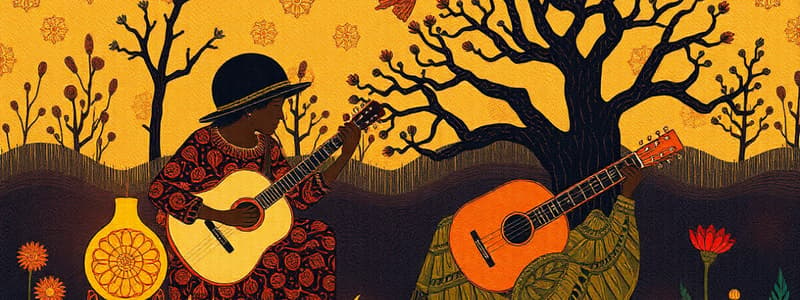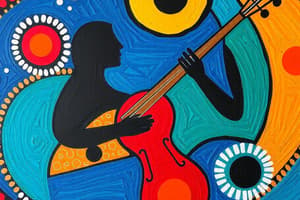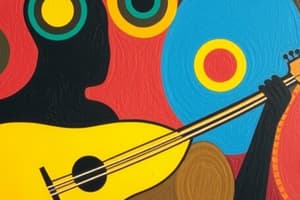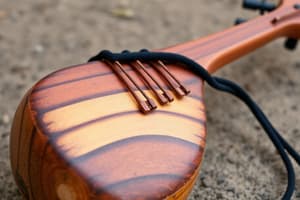Podcast
Questions and Answers
What material is used to create the mouthpiece of a yidaki?
What material is used to create the mouthpiece of a yidaki?
- Tree bark
- Wax or resin (correct)
- Eucalyptus leaves
- Termite mounds
How is sound produced on a yidaki?
How is sound produced on a yidaki?
- By striking the instrument with sticks
- By vibrating one's lips against the mouthpiece (correct)
- By blowing air across the top of the instrument
- By whirling the instrument
According to one legend, how was the yidaki discovered?
According to one legend, how was the yidaki discovered?
- A man carved a tube out of eucalyptus wood.
- A man discovered a natural wax seal on a eucalyptus branch and blew through it.
- A man mimicked the sound of the bull-roarer using a eucalyptus branch.
- A man found a log hollowed by termites and blew through it. (correct)
How do yidaki players maintain a continuous drone?
How do yidaki players maintain a continuous drone?
What is the approximate age of the oldest known yidaki?
What is the approximate age of the oldest known yidaki?
What is the primary function of clapsticks?
What is the primary function of clapsticks?
What description best describes a bull-roarer's sound?
What description best describes a bull-roarer's sound?
What is the range of a yidaki?
What is the range of a yidaki?
Flashcards
Yidaki
Yidaki
A long tube instrument made from hollowed eucalyptus wood.
Playing Technique
Playing Technique
Involves lips vibrating against a wax seal and blowing down the tube.
Breathing Method
Breathing Method
Players puff out cheeks, storing air in the mouth while breathing through the nose.
Historical Origin
Historical Origin
Signup and view all the flashcards
Legend of Burbuk Boon
Legend of Burbuk Boon
Signup and view all the flashcards
Health Benefits
Health Benefits
Signup and view all the flashcards
Yidaki Range
Yidaki Range
Signup and view all the flashcards
Clapsticks
Clapsticks
Signup and view all the flashcards
Study Notes
Yidaki
- The yidaki (also called didgeridoo by Europeans) is a long tube made from eucalyptus wood.
- It is hollowed out and the bark is removed.
- A ring of wax or resin is applied around the mouthpiece.
- It can be plain or decorated.
- Playing involves placing lips against the wax and vibrating them.
- Air is blown down the tube to produce a low-pitched drone.
- Players may puff out their cheeks and store air in the mouth for other sounds.
- The yidaki is played with other instruments or alone.
- Aboriginal Australians have played the yidaki for over 2,000 years.
Other Instruments
- Clapsticks are pairs of sticks, 8 inches (20 cm) long, that are clapped together.
- Clapsticks are often used to keep time for songs and dances.
- Bull-roarer is a flat, leaf-shaped piece of wood attached to a string.
- The bull-roarer is whirled to create a low-pitched roar.
Playing the Yidaki
- Playing involves a bit like playing a tuba or trombone.
- Players place their lips against a wax seal.
- Players vibrate lips as they blow down the long tube to produce a low-pitched drone.
- They puff out their cheeks and store air in their mouth, breathing through their nose
- They can mimic animal sounds.
Yidaki in History
- According to First Nations Australians the first yidaki was discovered by a man named Burbuk Boon.
- Burbuk Boon found a hollow log that was warmed by the fire.
- He used it and created sounds with it.
Studying That Suits You
Use AI to generate personalized quizzes and flashcards to suit your learning preferences.




